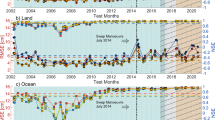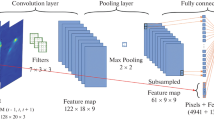Abstract
Traditional methods of bathymetry inversion from altimetry data often use gravity anomalies and/or vertical gravity anomaly gradients. These two gravity products are usually computed from vertical deflections; however, vertical deflections are rarely used for bathymetric studies. We argue that if gravity anomalies and vertical gravity anomaly gradients are derived from vertical deflections, then it suffices to conclude that vertical deflections also contain bathymetric information that can be exploited. To this end, convolutional neural network (CNN) was used to merge these three gravity signals to enhance the bathymetry of the Gulf of Guinea. The CNN-derived model compared well with individual models computed from each gravity signal using conventional methods of bathymetry inversion, as well as ship-borne depths, SRTM15+V2 and GEBCO_2021 used as references. Bathymetric profiles from all four inverted models compared well with profiles from ship-borne depths, proving that bathymetric information from vertical deflections is reliable. This eliminates the extra time and resources required to convert vertical deflections into gravity anomalies and vertical gravity anomaly gradients before inverting bathymetry. The predicted bathymetries from each gravity field signal generally depicted the ship-borne bathymetry. They yielded almost same performance metrics; however, these metrics were poorer than those observed from the CNN-derived model. The mean errors, error standard deviations, and correlation coefficients of the CNN-derived bathymetry and conventionally derived models were, respectively, − 6.45 m, 123.93 m, 0.9750, and − 9.86 m, 151.60 m, 0.9623. Spectral coherency analysis showed that the ship-borne depths correlated with the CNN-derived model better than with the other models. Results from this study testify to CNN’s computational efficacy in extracting features from geospatial datasets as witnessed in other geoscience disciplines.












Similar content being viewed by others
References
Alipourfard T, Arefi H, Mahmoudi S (2018) A novel deep learning framework by combination of subspace-based feature extraction and convolutional neural networks for hyperspectral images classification. In: IGARSS 2018–2018 IEEE International geoscience and remote sensing symposium. pp 4780–4783
Andersen OB (2013) Marine gravity and geoid from satellite altimetry. In: Sanso F, Sideris MG (eds) Geoid determination: theory and methods. Springer-Verlag, Heidelberg, pp 401–451
Andersen OB, Knudsen P (2019) The DTU17 global marine gravity field: first validation results. In: Mertikas SP, Pail R (eds) Fiducial reference measurements for altimetry. Springer, Cham, pp 83–87
Andersen OB, Zhang S, Sandwell DT et al (2021) The unique role of the jason geodetic missions for high resolution gravity field and mean sea surface modelling. Remote Sens 13:646. https://doi.org/10.3390/rs13040646
Annan RF, Wan X (2020) Mapping seafloor topography of gulf of Guinea using an adaptive meshed gravity-geologic method. Arab J Geosci 13:12. https://doi.org/10.1007/s12517-020-05297-8
Annan RF, Wan X (2021) Recovering marine gravity over the gulf of guinea from multi-satellite sea surface heights. Front Earth Sci 9:700873. https://doi.org/10.3389/feart.2021.700873
Banchani J-PS (2016) The relevance of the Gulf of Guinea in global energy politics. Afr Secur Rev 25:420–426
Brownfield ME, Charpentier RR (2006) Geology and total petroleum systems of the Gulf of Guinea province of West Africa. U.S. Geological Survey Bulletin 2207-C
Bucha B, Janák J (2013) A MATLAB-based graphical user interface program for computing functionals of the geopotential up to ultra-high degrees and orders. Comput Geosci 56:186–196. https://doi.org/10.1016/j.cageo.2013.03.012
Calmant S, Baudry N (1996) Modelling bathymetry by inverting satellite altimetry data: a review. Mar Geophys Res 18:123–134. https://doi.org/10.1007/BF00286073
Dixon TH, Naraghi M, McNutt MK, Smith SM (1983) Bathymetric prediction from SEASAT altimeter data. J Geophys Res 88:1563–1571. https://doi.org/10.1029/JC088iC03p01563
Dorman LM, Lewis BTR (1970) Experimental isostasy: 1 theory of the determination of the Earth’s isostatic response to a concentrated load. J Geophys Res 75:3357–3365. https://doi.org/10.1029/JB075i017p03357
Hsiao Y-S, Kim JW, Kim KB et al (2011) Bathymetry estimation using the gravity-geologic method: an investigation of density contrast predicted by the downward continuation method. Terr Atmos Ocean Sci 22:347. https://doi.org/10.3319/TAO.2010.10.13.01(Oc)
Hsiao Y-S, Hwang C, Cheng Y-S et al (2016) High-resolution depth and coastline over major atolls of South China Sea from satellite altimetry and imagery. Remote Sens Environ 176:69–83. https://doi.org/10.1016/j.rse.2016.01.016
Hu M, Li J, Li H, Xin L (2014) Bathymetry predicted from vertical gravity gradient anomalies and ship soundings. Geod Geodyn 5:41–46. https://doi.org/10.3724/SP.J.1246.2014.01041
Hu M, Jin T, Jiang W et al (2021) Bathymetry model in the northwestern pacific ocean predicted from satellite altimetric vertical gravity gradient anomalies and ship-board depths. Mar Geodesy. https://doi.org/10.1080/01490419.2021.1943576
Hwang C (1998) Inverse Vening Meinesz formula and deflection-geoid formula: applications to the predictions of gravity and geoid over the South China Sea. J Geod 72:304–312
Hwang C, Hsu H-Y, Jang R-J (2002) Global mean sea surface and marine gravity anomaly from multi-satellite altimetry: applications of deflection-geoid and inverse Vening Meinesz formulae. J Geod 76:407–418. https://doi.org/10.1007/s00190-002-0265-6
Ibrahim A, Hinze WJ (1972) Mapping buried bedrock topography with gravity. Ground Water 10:18–23
Kim S (2017) Machine learning. MATLAB deep learning. Apress, Berkeley
Kim JW, von Frese RRB, Lee BY et al (2011) Altimetry-derived gravity predictions of bathymetry by the gravity-geologic method. Pure Appl Geophys 168:815–826. https://doi.org/10.1007/s00024-010-0170-5
Li S, Chen J, Xiang J (2020) Applications of deep convolutional neural networks in prospecting prediction based on two-dimensional geological big data. Neural Comput Appl 32:2037–2053. https://doi.org/10.1007/s00521-019-04341-3
Osaretin I (2011) Energy security in the Gulf of Guinea and the challenges of the great powers. J Social Sci 27:187–191. https://doi.org/10.1080/09718923.2011.11892919
Paluszek M, Thomas S (2019) MATLAB machine learning recipes: a problem-solution approach. Apress, Berkeley
Parker RL (1972) The rapid calculation of potential anomalies. Geophys J Int 31:447–455. https://doi.org/10.1111/j.1365-246X.1973.tb06513.x
Sandwell DT, Smith WHF (1997) Marine gravity anomaly from Geosat and ERS 1 satellite altimetry. J Geophys Res 102:10039–10054. https://doi.org/10.1029/96JB03223
Sandwell DT, Smith WHF (2001) Bathymetric estimation. In: Fu L-L, Cazenave A (eds) Satellite altimetry and earth sciences: a handbook of techniques and applications. Academic Press, San Diego, California, pp 441–457
Sandwell DT, Harper H, Tozer B, Smith WHF (2019) Gravity field recovery from geodetic altimeter missions. Adv Space Res. https://doi.org/10.1016/j.asr.2019.09.011
Sandwell DT, Smith WHF, Gille S, et al (2001) Bathymetry from space: white paper in support of a high-resolution, ocean altimeter mission. In: High-resolution ocean topography science working group meeting
Sideris MG (2016) The FFT in local gravity field determination. Encycl Geodesy. https://doi.org/10.1007/978-3-319-02370-0_39-1
Small C, Sandwell DT (1992) A comparison of satellite and shipboard gravity measurements in the Gulf of Mexico. Geophysics 57:885–893. https://doi.org/10.1190/1.1443301
Smith WHF, Sandwell DT (1994) Bathymetric prediction from dense satellite altimetry and sparse shipboard bathymetry. J Geophys Res 99:21803–21824. https://doi.org/10.1029/94JB00988
Tozer B, Sandwell DT, Smith WHF et al (2019) Global Bathymetry and Topography at 15 Arc Sec: SRTM15+. Earth Space Sci 6:1847–1864. https://doi.org/10.1029/2019EA000658
Wan X, Annan RF, Wang W (2020) Assessment of HY-2A GM data by deriving the gravity field and bathymetry over the Gulf of Guinea. Earth, Planets and Space 72:13. https://doi.org/10.1186/s40623-020-01291-2
Wang YM (2000) Predicting bathymetry from the earth’s gravity gradient anomalies. Mar Geodesy 23:251–258. https://doi.org/10.1080/01490410050210508
Wessel P, Luis JF, Uieda L et al (2019) The generic mapping tools version 6. Geochem Geophys Geosyst 20:5556–5564. https://doi.org/10.1029/2019GC008515
Xiang X, Wan X, Zhang R et al (2017) Bathymetry inversion with the gravity-geologic method: a study of long-wavelength gravity modeling based on adaptive mesh. Mar Geodesy 40:329–340. https://doi.org/10.1080/01490419.2017.1335257
Xu H, Wang D, Ding Z et al (2020) Application of convolutional neural network in predicting groundwater potential using remote sensing: a case study in southeastern Liaoning, China. Arab J Geosci 13:1–12. https://doi.org/10.1007/s12517-020-05585-3
Yang Z, Jiang W, Xu B et al (2017) A Convolutional neural network-based 3D semantic labeling method for ALS point clouds. Remote Sens 9:936. https://doi.org/10.3390/rs9090936
Yao C, Zhang Y, Zhang Y, Liu H (2017) Application of convolutional neural network in classification of high resolution agricultural remote sensing images. Int Arch Photogramm Remote Sens Spatial Inf Sci 1:989–992. https://doi.org/10.5194/isprs-archives-XLII-2-W7-989-2017
Zhang S, Sandwell DT, Jin T, Li D (2017) Inversion of marine gravity anomalies over southeastern China seas from multi-satellite altimeter vertical deflections. J Appl Geophys. https://doi.org/10.1016/j.jappgeo.2016.12.014
Zhu C, Guo J, Hwang C et al (2019) How HY-2A/GM altimeter performs in marine gravity derivation: assessment in the South China Sea. Geophys J Int 219:1056–1064. https://doi.org/10.1093/gji/ggz330
Zhu C, Guo J, Gao J et al (2020) Marine gravity determined from multi-satellite GM/ERM altimeter data over the South China Sea: SCSGA V1.0. J Geod 94:50. https://doi.org/10.1007/s00190-020-01378-4
Acknowledgements
The authors are grateful to SIO for providing SRTM15+V2 and the SIO gravity models. We say ‘thank you’ to Blažej Bucha for making GrafLab available. We are grateful to DTU for providing DTU19MDT. Again, we appreciate the services of ESA, NASA/JPL and AVISO for providing GDRs of Cryosat-2, Jason-1/GM, and SARAL/AltiKa and Jason-2/GM, respectively. The National Satellite Ocean Application Service of China is appreciated for providing HY-2A dataset. The provision of ship-borne depths by the National Centers for Environmental Information of the National Oceanic and Atmospheric Administration is also highly recognized. The ICGEM is appreciated for the provision of EGM2008. We thank British Oceanographic Data Centre for making GEBCO_2021 accessible. Last but not least, the maps and some analyses in this study were made using the Generic Mapping Tools (Wessel et al. 2019).
Funding
This research was funded by the National Natural Science Foundation of China (Nos. 42074017, 41674026); Fundamental Research Funds for the Central Universities (No. 2652018027); Open Research Fund of Qian Xuesen Laboratory of Space Technology, CAST (No. GZZKFJJ2020006).
Author information
Authors and Affiliations
Contributions
Conceptualization, both authors; methodology, both authors; data curation, both authors; funding acquisition, XW; formal analysis, RFA; investigation, both authors; writing-original draft preparation, RFA; writing-review and editing, both authors.
Corresponding author
Ethics declarations
Conflict of interest
The authors declare that this research was conducted in the absence of any commercial or financial relationships that could be construed as a potential conflict of interest.
Additional information
Publisher's Note
Springer Nature remains neutral with regard to jurisdictional claims in published maps and institutional affiliations.
Rights and permissions
About this article
Cite this article
Annan, R.F., Wan, X. Recovering Bathymetry of the Gulf of Guinea Using Altimetry-Derived Gravity Field Products Combined via Convolutional Neural Network. Surv Geophys 43, 1541–1561 (2022). https://doi.org/10.1007/s10712-022-09720-5
Received:
Accepted:
Published:
Issue Date:
DOI: https://doi.org/10.1007/s10712-022-09720-5




